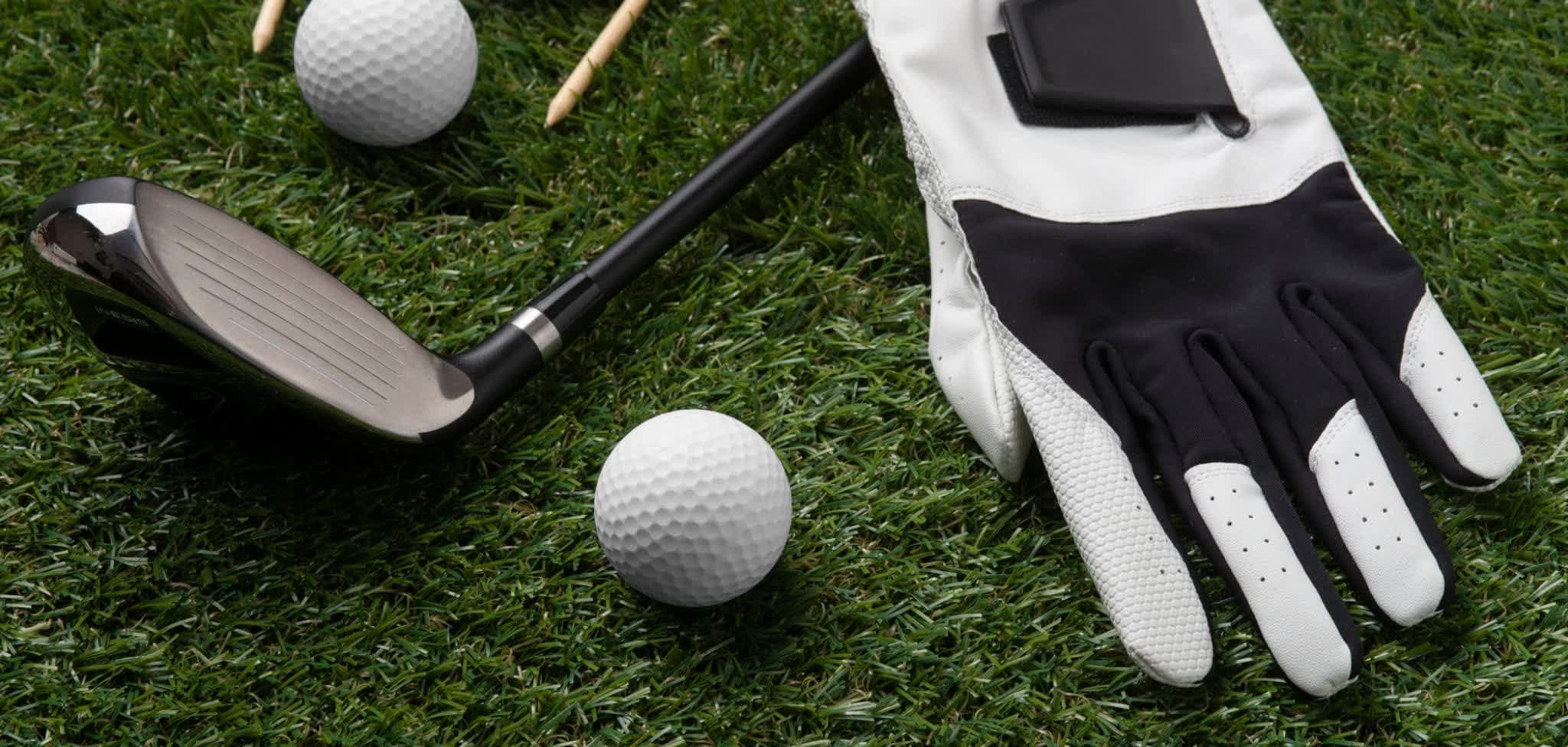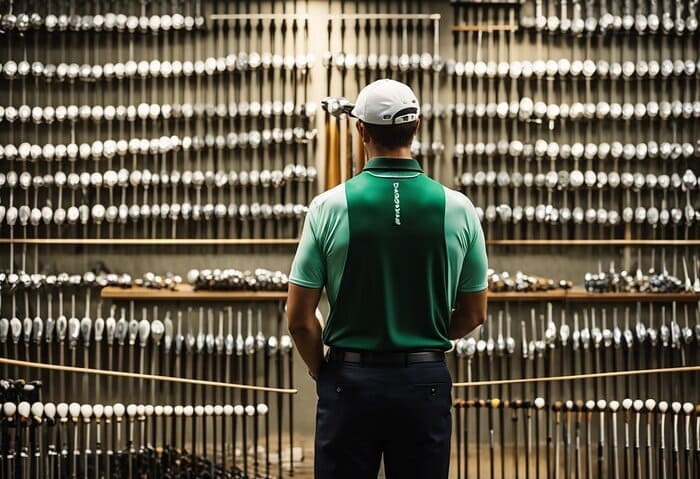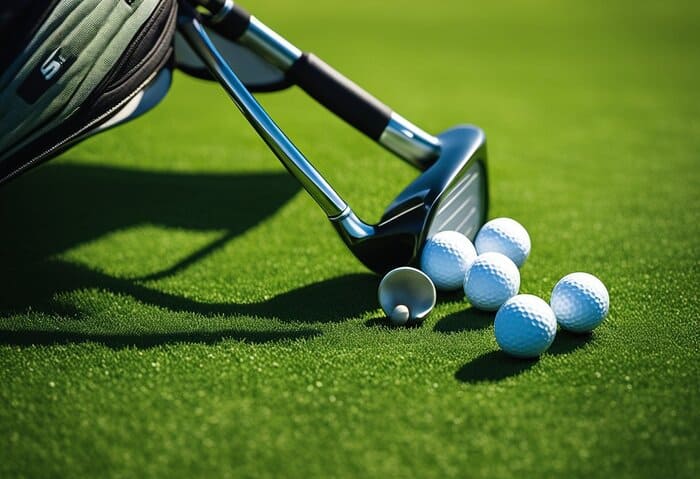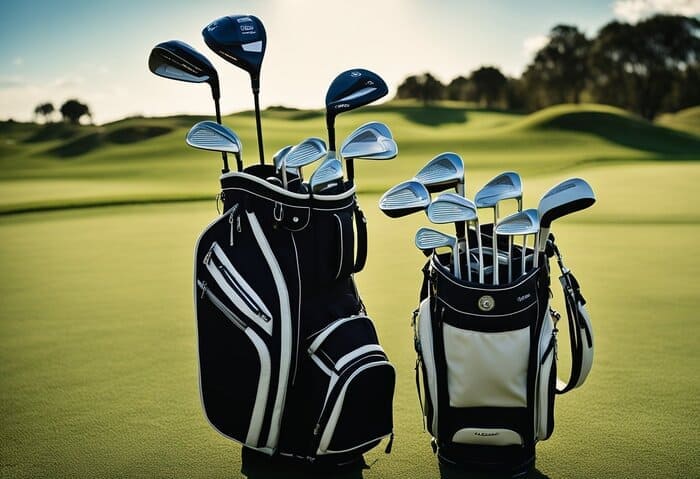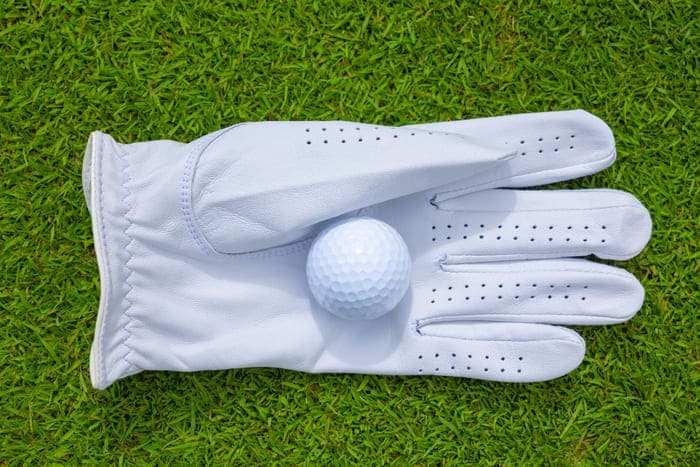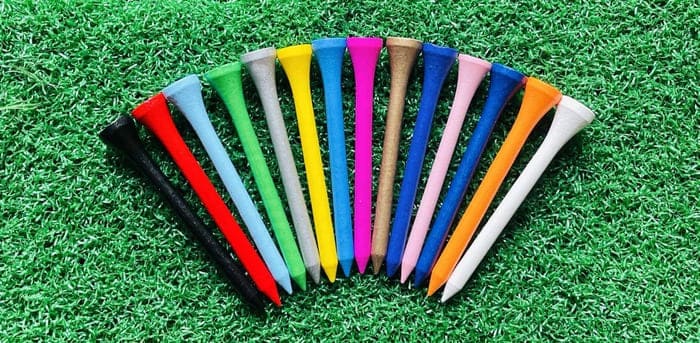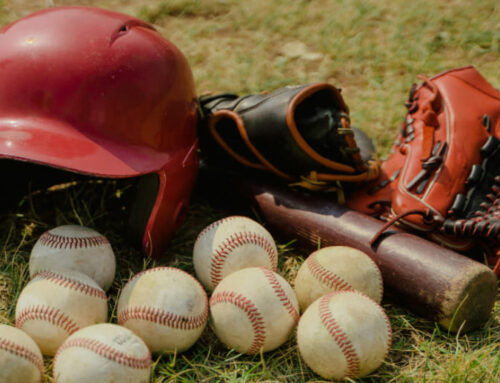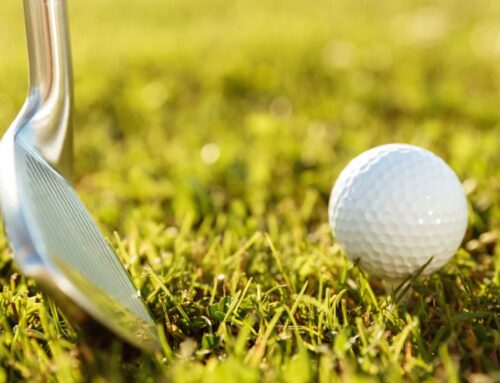A Comprehensive Beginner’s Guide to Golf Equipment
Golf is a sport that combines skill, precision, and a love for the outdoors. If you’re thinking about getting into golf, you’ll need to have some basic knowledge about the equipment to set yourself up for success. It can be overwhelming for beginners to know where to start, but In this comprehensive guide, we will walk you through the essential golf equipment you’ll need, discuss the different types of clubs, offer tips on selecting the right gear, and provide valuable insights from expert sources.
Introduction to Golf Equipment
Golf is a sport that requires specific equipment to play. As a beginner, understanding the different components and functions of golf equipment is crucial for your progress in the game. Golf equipment can be divided into several categories, including golf clubs, golf balls, golf bags, golf gloves, golf shoes, golf tees, and various accessories. Each piece serves a specific role in your game and contributes to your overall performance on the golf course.
To get started, let’s examine the most essential piece of golf equipment: golf clubs.
Golf Clubs: The Foundation of Your Game
Golf clubs are the tools you use to strike the ball and navigate the course. As a beginner, it’s important to have a basic understanding of the different types of golf clubs and their purposes. While professional golfers are allowed to carry up to 14 clubs in their bags, beginners can start with a smaller set that includes the essentials.
Understanding the Different Types of Golf Clubs
Golf clubs can be categorized into several types, each serving a specific purpose in your game. Here are the main types of golf clubs you should be familiar with:
- Driver: also known as the 1-wood, is designed to hit the ball off the tee and achieve maximum distance. It has the longest shaft and largest clubhead among all the clubs. Beginners should opt for a driver with a higher loft to make it easier to launch the ball.
- Fairway Woods: are versatile clubs used for longer shots from the fairway or off the tee on shorter holes. They have smaller clubheads and shorter shafts compared to drivers. Common fairway woods include the 3-wood and 5-wood, which offer a balance between distance and control.
- Hybrids: also known as rescue clubs are a cross between a fairway wood and an iron. They are designed to provide forgiveness and ease of use. Hybrids are particularly useful for shots in the rough or when facing long approach shots. Beginners may find hybrids easier to hit than long irons.
- Irons: are the most versatile clubs in your bag and are used for a variety of shots, including approach shots from the fairway, chipping, and pitching. Irons have shorter shafts and smaller clubheads compared to woods. They are numbered from 3 to 9, with the lower numbers having less loft and more distance.
- Wedges: are specialized irons used for shots around the green and in sand bunkers. They have higher lofts and shorter shafts, allowing for precise control and the ability to generate spin. The most common wedges are the pitching wedge, sand wedge, and lob wedge.
- Putter: is the club used on the green to roll the ball into the hole. Putters have a flat clubface and are designed for accuracy rather than distance. There are various styles of putters, including blade putters and mallet putters, each with its own design features and benefits.
Selecting the Right Golf Shaft for Your Swing
In addition to the clubhead design, the golf shaft plays a crucial role in your swing and the overall performance of the club. Golf shafts are typically made of either graphite or steel, each offering different characteristics.
- Graphite Shafts: are lighter and more flexible than steel shafts. They are ideal for golfers with slower swing speeds or those seeking more distance. Graphite shafts can help generate more clubhead speed, resulting in increased distance. They also absorb vibrations better, providing a more comfortable feel.
- Steel Shafts: are heavier and more rigid than graphite shafts. They offer better control and accuracy, making them suitable for golfers with faster swing speeds or those who prefer a more consistent feel. Steel shafts are generally less expensive than graphite shafts and are known for their durability.
When selecting a golf shaft, it’s essential to consider your swing speed, strength, and personal preferences. If you’re unsure, consult with a golf professional or club fitting expert who can analyze your swing and recommend the appropriate shaft flex and material.
Determining Your Budget for Golf Clubs
As a beginner, it’s important to set a reasonable budget for your golf clubs. While it’s tempting to invest in top-of-the-line clubs, keep in mind that your skill level and progress will evolve over time. Starting with a more affordable set of clubs allows you to focus on learning the fundamentals without breaking the bank.
The cost of golf clubs can vary significantly depending on the brand, model, and whether you choose new or used clubs. New clubs from reputable manufacturers can range from a few hundred to several thousand dollars for a complete set. However, there are also budget-friendly options available from lesser-known brands that offer good quality for beginners.
If you’re on a tight budget, consider purchasing used clubs. Many golfers upgrade their equipment regularly, making used clubs a viable and cost-effective option. Just be sure to inspect the clubs for any signs of wear or damage before making a purchase.
Weighing the Pros and Cons of New vs. Used Golf Clubs
When deciding between new and used golf clubs, there are pros and cons to consider for each option.
New Golf Clubs:
- Pros:
- Guaranteed quality and performance
- Access to the latest club technologies and advancements
- Customization options for shafts, grips, and clubhead specifications
- Cons:
- Higher price point, especially for premium brands and models
- Limited room for experimentation if your swing or preferences change
Used Golf Clubs:
- Pros:
- More affordable than new clubs, allowing for cost savings
- Access to reputable brands and models at a lower price point
- Opportunity to try different club designs and configurations without a significant financial commitment
- Cons:
- Potential for wear and tear, depending on the condition of the used clubs
- Limited availability of specific models or custom options
- Less certainty about the performance and longevity of the clubs
Ultimately, the decision between new and used clubs depends on your budget, preferences, and long-term commitment to the game. If you’re just starting and unsure about your golfing journey, used clubs can be a practical and economical choice. However, if you’re passionate about the sport and willing to invest in quality equipment, new clubs offer the latest technology and customization options.
In the next section, we will explore another critical component of your golfing arsenal: the golf ball.
Golf Balls: Choosing the Perfect Fit
Golf balls may seem simple, but they play a significant role in your game. Every shot you take involves contact with the golf ball, making it crucial to choose the right ball for your skill level and playing style. In this section, we will discuss the importance of golf ball selection, factors to consider when choosing golf balls and explore different options available in the market.
The Importance of Golf Ball Selection
Golf balls are not one-size-fits-all; different balls offer varying characteristics that can impact your performance on the course. Choosing the right golf ball can help maximize distance, control, and overall playability. Here are a few reasons why golf ball selection is important:
- Distance: Golf balls are designed to optimize distance based on factors such as compression, dimple pattern, and core construction. Selecting a ball with the appropriate compression for your swing speed can help you achieve greater distance off the tee and with your irons.
- Control: Golf balls differ in terms of spin rates, which can affect the amount of control you have over your shots. Higher-spin balls are ideal for players who want greater control around the greens, while lower-spin balls may provide more distance but less stopping power.
- Feel: The feel of a golf ball is subjective but can impact your overall experience and confidence on the course. Some golfers prefer a softer feel, while others prefer a firmer response off the clubface. Finding a ball that suits your personal preference can enhance your enjoyment of the game.
Factors to Consider When Choosing Golf Balls
When selecting golf balls, several factors should be taken into account to ensure the right fit for your game. Here are some key considerations:
- Skill Level: Golf balls are designed to cater to different skill levels, from beginner to professional. As a beginner, choose balls that offer forgiveness and distance to help compensate for any inconsistencies in your swing.
- Swing Speed: Your swing speed affects the compression of the ball upon impact. Slower swing speeds typically benefit from lower-compression balls, while higher swing speeds may require higher-compression balls for optimal performance.
- Playing Conditions: Consider the typical weather and course conditions in which you play. Softer balls may offer better performance in cooler temperatures, while harder balls may be more resilient in hot conditions.
- Budget: Golf balls come at various price points, and it’s important to balance your budget with your performance needs. Keep in mind that as a beginner, you may lose balls more frequently, so opting for more affordable options can be practical.
Exploring Different Golf Ball Options
The golf ball market offers a wide range of options to suit different players. Here are some popular types of golf balls you may consider:
- Two-piece Golf Balls: are designed for maximum distance and durability. They have a solid rubber core and a durable cover, making them ideal for beginners seeking distance and forgiveness.
- Three-piece Golf Balls: offer a balance between distance and control. They feature a solid core, an intermediate layer for added control, and a soft cover. These balls are suitable for players looking for a combination of distance and spin control.
- Multi-layer Golf Balls: typically four or five pieces, are designed for advanced players seeking maximum performance. These balls offer enhanced control, spin, and feel, making them ideal for experienced golfers with consistent swings.
- Low Compression Golf Balls: These are designed for slower swing speeds. They compress more upon impact, resulting in increased distance and a softer feel. These balls can be beneficial for beginners or players with slower swings.
- High Compression Golf Balls: These are designed for faster swing speeds. They maintain their shape and offer better control for players with higher swing speeds. These balls may be suitable for more experienced golfers seeking additional distance and precision.
When choosing golf balls, it’s essential to try different options to find the ball that suits your game and preferences. Consider experimenting with various brands, models, and constructions to identify the ball that provides the best combination of distance, control, and feel for your swing.
In the next section, we will explore another crucial piece of golf equipment: the golf bag.
Golf Bags: Carrying Your Equipment in Style
A golf bag is more than just a means of carrying your golf clubs; it is an essential accessory that provides organization, protection, and convenience on the golf course. In this section, we will discuss the different types of golf bags, considerations when choosing a golf bag, and essential features to look for.
Types of Golf Bags: Cart Bags vs. Stand Bags
Golf bags can be broadly categorized into two main types: cart bags and stand bags. Each type offers unique features and benefits, catering to different playing preferences and needs.
Cart Bags: Specifically designed to be used with golf carts or push carts, these bags are known for their larger and more spacious build, providing ample storage capacity. The key feature of cart bags lies in their organization; they often boast multiple pockets, dividers, and specialized compartments to ensure that your clubs are neatly arranged and easily accessible during a round. Ideal for golfers who prefer the convenience of riding in a cart or using a push cart to navigate the course, these bags cater to those who prioritize both functionality and ease of access.
Stand Bags: As the name suggests, these bags are equipped with built-in legs that enable them to stand upright on the ground. They are specifically designed for golfers who prefer carrying their bags or utilizing a caddie. Stand bags are characterized by their lighter and more compact build compared to cart bags, making them highly portable. With comfortable shoulder straps, hip pads, and ergonomic handles, stand bags prioritize ease of carrying. They cater to golfers who enjoy walking the course and seek the convenience of a bag that effortlessly stands upright when not in use.
Considerations When Choosing a Golf Bag
When selecting a golf bag, several factors should be taken into consideration to ensure it meets your specific needs and preferences. Here are some key considerations:
- Usage: Determine how you plan to use the bag. If you primarily ride in a cart or use a push cart, a cart bag may be more suitable. If you prefer to walk the course or have a caddie, a stand bag may be a better fit.
- Storage Capacity: Assess your storage needs and consider the number of clubs, accessories, and personal items you typically carry during a round. Ensure the bag has enough dividers, pockets, and compartments to accommodate your equipment.
- Weight and Portability: Consider the weight of the bag, especially if you plan to carry it. Lighter bags with comfortable straps and ergonomic features can make a significant difference in your overall experience on the course.
- Durability and Protection: Look for bags made of durable materials that can withstand the rigors of the golf course. Reinforced club dividers, padded straps, and sturdy construction will help protect your clubs and equipment.
- Comfort and Convenience: Evaluate the bag’s features in terms of comfort and convenience. Padded straps, hip pads, and ergonomic handles can make carrying the bag more comfortable. Easy-access pockets, towel loops, and umbrella holders are examples of convenient features to consider.
Features to Look for in a Golf Bag
When examining golf bags, keep an eye out for the following features that can enhance your overall golfing experience:
- Club Dividers: Dividers help organize and protect your clubs, preventing them from clanging together during transportation. Look for bags with full-length individual dividers or at least four to five dividers for optimal organization.
- Pockets and Compartments: Determine the number and size of pockets you need to store your accessories, such as balls, tees, gloves, and personal items. Consider specialized pockets for valuables, coolers, and apparel.
- Comfortable Straps and Handles: Look for bags with padded straps that distribute weight evenly across your shoulders and back. Ergonomic handles and hip pads can also contribute to the bag’s overall comfort and ease of use.
- Rain Hood: A rain hood is a detachable cover that protects your clubs and equipment from rain. Bags with built-in rain hoods ensure your gear stays dry during inclement weather.
- Stability and Balance: Ensure the bag stands securely and balances well when loaded with clubs. Stable legs and a well-designed base prevent the bag from tipping over and provide stability on various surfaces.
- Quality and Durability: Invest in a bag made of high-quality materials, reinforced stitching, and durable zippers. A well-constructed bag will withstand regular use and last longer.
Remember to consider your personal preferences, playing style, and budget when selecting a golf bag. It’s recommended to visit a golf store or pro shop to physically examine and try different bags to determine which one best suits your needs.
In the next section, we will explore another crucial piece of golf equipment: golf gloves.
Golf Gloves: Enhancing Your Grip and Performance
Golf gloves may seem like a small accessory, but they play a crucial role in your grip and overall performance on the golf course. They provide additional grip, comfort, and protection for your hands, ensuring a secure connection between your hands and the club. In this section, we will discuss the importance of golf gloves, finding the right fit and material, and tips for maintaining and caring for your gloves.
The Role of Golf Gloves in Your Game
Golf gloves offer several benefits that can improve your game and enhance your overall experience on the course. Here are some key reasons why golf gloves are essential:
- Enhanced Grip: The primary function of a golf glove is to provide a better grip on the club. The glove’s material, typically leather or synthetic, offers friction and prevents slipping, ensuring a secure hold during your swing.
- Increased Control: With a better grip, you gain more control over the club, resulting in improved accuracy and consistency. A secure connection between your hands and the club promotes a smoother swing and helps prevent the club from twisting in your hands.
- Reduced Friction and Pressure: Golf gloves act as a barrier between your hands and the club, reducing friction and minimizing the risk of blisters or calluses. They provide cushioning and absorb some of the pressure generated during impact.
- Improved Comfort: Golf gloves offer additional comfort during your round, especially in hot and humid conditions. They can absorb sweat and prevent your hands from becoming slippery, allowing you to maintain a confident and relaxed grip.
Finding the Right Fit and Material for Golf Gloves
When selecting golf gloves, two primary considerations are fit and material. Finding the right fit ensures maximum comfort and optimal performance, while choosing the appropriate material depends on personal preference and playing conditions. Here are some guidelines for finding the perfect golf glove:
- Fit: Golf gloves should fit snugly but not too tight. A glove that is too loose can affect your grip and feel, while one that is too tight may restrict your hand movements. To determine your glove size, measure the circumference of your dominant hand just below the knuckles.
- Material: Golf gloves are available in various materials, with leather and synthetic being the most common options.
- Leather Gloves: offer a soft, luxurious feel and tend to conform to your hand over time. They provide excellent grip and breathability, making them suitable for most playing conditions. However, leather gloves may require more maintenance and can be pricier than synthetic alternatives.
- Synthetic Gloves: are typically made of synthetic materials such as synthetic leather or synthetic microfiber. They are more affordable, durable, and resistant to moisture. Synthetic gloves often offer a snug fit and require less maintenance. They are particularly suitable for hot and humid conditions.
- Closure Type: Golf gloves come with various closure types, including hook-and-loop (Velcro) straps, snap buttons, or traditional buttons. Choose a closure type that allows for easy adjustment and a secure fit.
It’s essential to try on different brands and models of golf gloves to find the one that suits your hand shape, size, and personal preference. Comfort and feel are subjective, so take the time to find the glove that offers the best combination of grip, comfort, and durability for your game.
Tips for Maintaining and Caring for Golf Gloves
To extend the lifespan of your golf gloves and ensure consistent performance, follow these tips for maintenance and care:
- Rotate Gloves: It’s beneficial to have multiple gloves in rotation to allow them to dry and rest between rounds. By rotating your gloves, you prevent excessive wear and help maintain their shape.
- Keep Your Gloves Dry: Avoid storing wet gloves in your golf bag or other enclosed spaces. After each round, allow them to air dry naturally, or consider using a glove drying device designed for this purpose.
- Regularly Clean Your Gloves: Over time, dirt, sweat, and oils can accumulate on your gloves, affecting their grip and feel. Periodically clean your gloves by gently washing them with mild soap and warm water. Rinse thoroughly and let them air dry.
- Properly Store Your Gloves: To prevent mold or mildew, store your gloves in a cool, dry place. Avoid exposing them to direct sunlight or extreme heat, as this can damage the materials.
By following these maintenance tips, you can prolong the life of your golf gloves and ensure they maintain their performance over time.
In the next section, we will explore another essential piece of golf equipment: golf shoes.
Golf Shoes: Stepping Up Your Game
Golf shoes are a pivotal piece of equipment, providing essential elements such as stability, traction, and comfort throughout your rounds. Crafted with precision, they are specifically engineered to deliver optimal grip and support while traversing diverse terrains on the golf course. In this section, we will delve into the profound importance of golf shoes, explore the different types available, and outline key considerations to guide you in selecting the perfect pair for your game.
Understanding the Importance of Golf Shoes
Golf shoes are more than just a fashion statement; they play a vital role in your performance and overall experience on the golf course. Here are some key reasons why golf shoes are important:
- Traction and Stability: Golf shoes feature specialized outsoles with spikes or traction nubs that provide grip and prevent slipping, especially during your swing. They offer stability and support, allowing you to maintain your balance throughout your round.
- Comfort and Cushioning: Golf shoes are designed with comfort in mind, providing cushioning and support for your feet during long walks on the course. The materials used in golf shoe construction ensure breathability and moisture-wicking properties, keeping your feet dry and comfortable.
- Style and Etiquette: Golf shoes are a traditional part of golfing attire and contribute to the overall professional appearance on the course. Many golf courses have dress codes that require players to wear proper golf shoes, ensuring a consistent experience for all players.
Exploring Different Types of Golf Shoes
Golf shoes come in various types, each catering to different preferences and playing conditions. Here are some common types of golf shoes:
- Spiked Golf Shoes: Traditional spiked golf shoes feature removable spikes on the outsole, typically made of plastic or metal. These spikes provide excellent traction and stability, especially in wet or hilly conditions. Spiked shoes are popular among professional golfers and players seeking maximum grip.
- Spikeless Golf Shoes: Spikeless golf shoes have traction nubs or lugs on the outsole instead of removable spikes. These shoes provide grip through the tread pattern rather than spikes, making them more versatile for both on-course and off-course wear. Spikeless shoes are known for their comfort and versatility.
Factors to Consider When Choosing Golf Shoes
When selecting golf shoes, several factors should be taken into consideration to ensure a proper fit and optimal performance. Here are some key factors to consider:
- Comfort and Fit: Golf shoes should fit snugly but not too tight. Look for shoes with ample cushioning, arch support, and a comfortable insole. Consider trying on different brands and models to find the one that suits your foot shape.
- Waterproofing: Golf courses can be wet, especially in the morning or after rainfall. Waterproof golf shoes can keep your feet dry and comfortable, preventing moisture from seeping in. Look for shoes with waterproof materials or treated uppers.
- Breathability: Golf shoes that allow for proper airflow and moisture-wicking properties can enhance comfort, especially in hot and humid conditions. Look for shoes with breathable materials and ventilation features.
- Traction and Stability: Consider the type of outsole and traction system on the shoes. Spiked shoes typically offer better traction on wet or hilly terrain, while spikeless shoes provide versatility and comfort.
- Style and Design: Golf shoes come in various styles and designs, allowing you to express your personal taste. Choose a pair that aligns with your preferences and complements your overall golfing attire.
When trying on golf shoes, wear the same socks you would typically wear during a round to ensure an accurate fit. Walk around and simulate your golf swing to assess comfort, stability, and overall feel. Remember that comfort and fit should be your top priorities when selecting golf shoes.
In the next section, we will explore another essential golf accessory: golf tees.
Golf Tees: Essential Accessories for Teeing Off
Golf tees are small but essential accessories that elevate your ball off the ground, allowing for a clean and stable shot from the tee box. While they may seem insignificant, the right choice of golf tees can impact your launch angle, distance, and overall performance. In this section, we will discuss the role of golf tees, selecting the right type and size, and tips for getting the most out of your golf tees.
The Role of Golf Tees in Your Game
Golf tees play a crucial role in setting up your shots from the tee box. They elevate the ball off the ground, providing a stable and consistent starting point for your swing. Here are some key reasons why golf tees are essential:
- Consistent Tee Height: Golf tees ensure that the ball is set at a consistent height for every shot from the tee box. This allows you to achieve the desired launch angle and control the trajectory of your shot.
- Optimal Ball Positioning: By using a tee, you can position the ball at the ideal spot in relation to your stance and swing. This ensures that you make clean contact with the ball and maximize your chances of hitting a solid shot.
- Versatility: Golf tees are not only used for tee shots on par 3s and par 4s but can also be used for longer approach shots on par 5s or when playing from the fairway. Teeing the ball up slightly can help you achieve a better ball flight and distance.
Selecting the Right Type and Size of Golf Tees
When selecting golf tees, consider the type and size that best suits your game and the club you’re using. Here are some guidelines to help you make the right choice:
- Type of Golf Tees: Golf tees come in different materials, including wood, plastic, and composite. Each material offers unique characteristics and advantages.
- Wooden Tees: Widely regarded as the most common and budget-friendly option, wooden tees provide stability and are environmentally friendly due to their biodegradable nature. With various length options available, you can easily find the right size for your club.
- Plastic Tees: Boasting durability and the ability to withstand multiple shots, plastic tees offer a consistent height and are less prone to breakage upon impact. These tees are a popular choice for golfers prioritizing longevity and convenience.
- Composite Tees: Combining the strengths of both wood and plastic, composite tees are more durable than their wooden counterparts and offer greater stability than plastic alternatives. Featuring a larger head, these tees provide additional support for the ball, delivering a balanced and reliable option for golfers seeking a middle ground between wood and plastic.
- Tee Height: Tee height is crucial for achieving the desired launch angle and distance. The appropriate tee height depends on the type of club you’re using:
- Driver: Tee the ball high enough to ensure the center of the ball aligns with the sweet spot of your driver. This generally requires a tee height of around 1.5 to 2.5 inches.
- Irons: For irons and fairway woods, tee the ball lower to create a more shallow angle of attack. This usually requires a tee height of around 0.5 to 1.5 inches.
- Hybrids: Tee height for hybrids can vary depending on personal preference and the specific hybrid club being used. Experiment with different tee heights to find the one that suits your swing and gives you the desired ball flight.
Tips for Getting the Most Out of Your Golf Tees
To maximize the benefits of using golf tees, consider the following tips:
- Carry Multiple Tees: Have a variety of tee sizes and types in your golf bag to accommodate different clubs and tee heights. This ensures that you always have the right tee for each shot.
- Position the Tee Correctly: Place the tee in the ground at a slight angle, leaning towards the target. This helps create the desired launch angle and promotes optimal ball flight.
- Tee Placement: Position the ball on the tee so that the equator of the ball is aligned with the top of the clubface. This allows for clean contact and optimal energy transfer at impact.
- Replace Broken Tees: If your tee breaks during a shot, replace it before teeing off again. A broken tee can affect the stability and accuracy of your shot.
Remember that golf tees are inexpensive and disposable, so don’t hesitate to experiment with different sizes, types, and tee heights to find what works best for your swing and playing style.
In the next section, we will explore another essential aspect of golf equipment: golf accessories.
Golf Accessories: Enhancing Your Golfing Experience
Golf accessories are supplementary items that can enhance your overall golfing experience and provide added convenience on the course. From essential accessories like golf balls and ball markers to optional extras like rangefinders and GPS devices, these accessories can help improve your game and make your rounds more enjoyable. In this section, we will discuss essential golf accessories for beginners, additional accessories to consider, and tips for organizing and maintaining your golf accessories.
Essential Golf Accessories for Beginners
As a beginner, certain golf accessories are essential for your game. These accessories help you navigate the course, mark your balls, and maintain your equipment. Here are some must-have golf accessories for beginners:
- Golf Ball Markers: these are small markers used to mark the position of your ball on the green. They prevent interference with other players’ putts and allow you to lift and clean your ball. Markers can be as simple as a coin or a specialized marker with personalized designs.
- Golf Towel: This is used to keep your clubs and balls clean during your round. It’s essential for wiping dirt, grass, and moisture off your equipment, ensuring optimal performance. Attach a golf towel to your golf bag for easy access during your round.
- Divot Repair Tool: also known as pitchforks, are used to repair divots on the green. Divots are depressions or marks caused by golf balls landing on the green. Repairing divots helps maintain the quality and playability of the green for all players.
- Golf Club Head Covers: these are protective covers for your clubheads. They help prevent damage and scratches during transportation and storage. Head covers are particularly important for drivers, fairway woods, and hybrids.
- Golf Bag Rain Cover: A rain cover for your golf bag provides protection during wet weather. It keeps your clubs and equipment dry, ensuring they remain in optimal condition. Look for a rain cover that fits securely over your bag and offers full coverage.
Read More
LEARN & GROW CORNER
Baseball for Beginners
Baseball for Beginners: A Comprehensive Guide to the Basics Baseball is one of the most popular sports in the United States, enjoyed by millions of people of all ages. It's a game that requires [...]
Collecting Paper Currency
Collecting Paper Currency Hobby: Tips and Tricks for Building a Unique Collection Are you interested in the world of paper currency collecting? If so, you're in for a treat. Collecting paper money is a [...]
Coin Collecting Hobby
Coin Collecting Hobby: A Guide to Starting Your Collection If you've ever found yourself fascinated by the intricate designs and historical significance of coins, you might want to consider starting a coin collecting hobby. [...]
The Stamp Collecting
The Stamp Collecting: A Comprehensive Guide Stamp collecting is a fascinating hobby that has been enjoyed by people all over the world for over a century. Whether you're a seasoned collector or a newcomer [...]
ABC Gardening Hobby
ABC Gardening Hobby: Tips and Tricks for Beginners If you're looking for a rewarding and enjoyable hobby, gardening might be the perfect fit for you. A B C Gardening is a beginner-friendly approach to [...]

